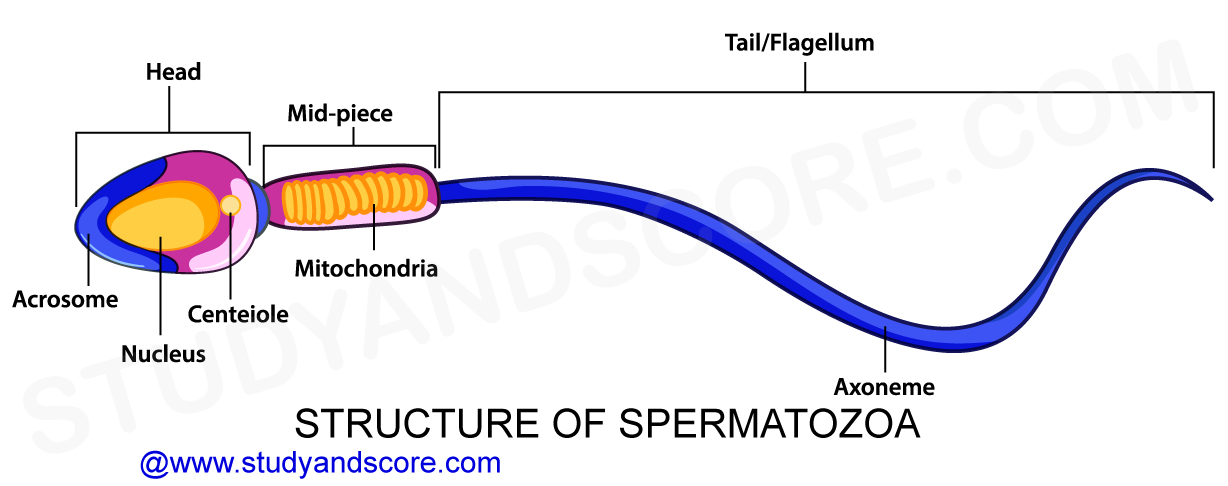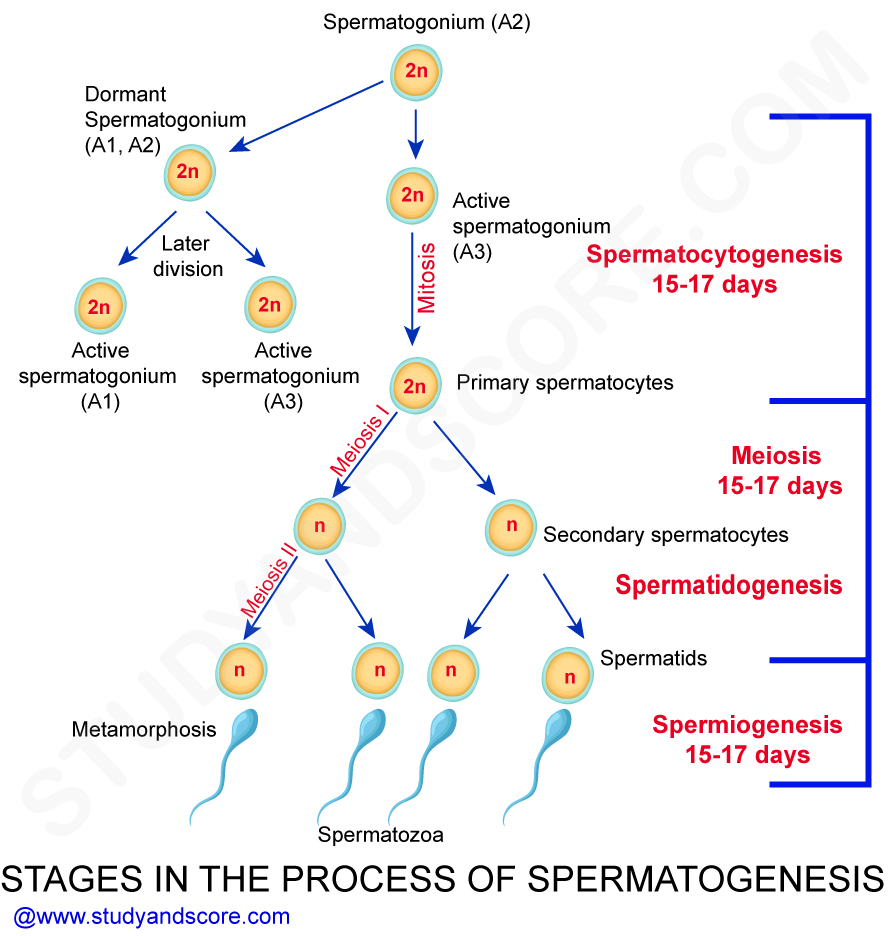The process by which the gametes or germ cells are produced from the germinal cells of the gonads is known as the gametogenesis. The gametes are formed in the sexes for their future role in the reproduction. During embryonic development the initial cells which are to form the functional gametes are described as primordial germ cells. They arise at a different site from that of gonads and once the gonads develop they migrate into them and become established. Hence these cells have an extra gonadal origin in most invertebrates and vertebrates.
In sexually reproducing animals there are two kinds of gametes. The female gamete or ovum or egg is invariably larger, non-motile and nutrient filled. The female gamete must be competent to be fertilized so it develops a number of specialized properties to enable it to interact with sperm.
The male gamete or spermatozoon or sperm is active, mobile and varies greatly in size and constitution. The sperm and ova are produced from the germinal cells present in their respective gonads, testes and ovaries. The formation of female gamete, ova or egg is known as oogenesis, whereas formation of male gamete or sperm is termed as spermatogenesis.
Both classes of gametes, spermatozoa and ova make an equal contribution to the nucleus of the zygote. In sexual reproduction union of gametes from two different individuals takes place, so either gamete possesses one half the numbers of chromosomes of the parents.
Thus the process of gametogenesis is quite complicated as the germinal cells are diploid containing double set of chromosomes and the gametes which are produced are haploid containing half the number of chromosomes found in the germinal cells. This reduction of chromosomal number is accomplished by meiotic division. Gametogenesis is designated as the first stage in embryonic development as they provide the blue print and raw material from which the embryo is formed.
In some animals, the spermatozoa and ova are produced by single individual, which is called as hermaphrodite or monoecious or bisexual. In others the two types of gametes are produced by different individuals and such individuals are called dioecious or unisexual\and this type of separation of individuals is called gonochorism.
The process in which male primary germ cells undergo division to produce a number of spermatogonia cells is called Spermatogenesis. Through these spermatogonia cells, primary spermatocytes are derived. Each primary spermatocyte is then divided into two secondary spermatocytes, and finally each secondary spermatocyte is re-divided into two spermatids or young spermatozoa. The spermatids develop into mature spermatozoa, also called as sperm cells. Thus, one primary spermatocyte gives rise to two secondary spermatocytes cells; each secondary spermatocyte cell undergoes further subdivisions to produce four spermatozoa.
Spermatozoa are the mature male gametes in many sexually reproducing organisms. Thus, spermatogenesis is the male version of gametogenesis. In mammals spermatozoa occurs in the male testes and epididymis. The process of spermatogenesis takes approximately 64 days in humans.
For the process of spermatogenesis to occur correctly, optimum conditions are very essential. Spermatogenesis starts at puberty and generally continues uninterrupted until death. There could be a slight decrease in the quantity of sperm with increase in age.
The main purpose of spermatogenesis is the production of mature male gametes. Male gametes are also called as sperm or spermatozoa. During conception, the male gametes (sperms) have the ability to fertilize the female gamete (oocyte), to produce a single-celled zygote. This is the basis of sexual reproduction and involves each of the two gametes contributing half the normal set of chromosomes (haploid) to result in a chromosomally normal (diploid) zygote.
The number of chromosomes differs from species to species. To preserve the number of chromosomes in the offspring each gamete must have half the usual number of chromosomes present in other body cells. Or else, the offspring will have twice the normal number of chromosomes and this may result in serious abnormalities.
In human beings, chromosomal abnormalities arising from improper spermatogenesis can result in Down syndrome, Klinefelter's Syndrome, and spontaneous abortion.

The location of spermatogenesis process is male reproductive system. The initial stages of this process occur inside the testes and further progress to the epididymis. In epididymis the developing gametes mature and are stored until ejaculation.
The seminiferous tubules of the testes are the starting point for the spermatogenesis process. Here the stem cells adjacent to the inner tubule wall divide in a centripetal direction beginning at the walls and proceeding into the innermost lumen to produce immature sperm. Maturation occurs in the epididymis and involves the attainment of a tail and so sperms gain motility.
Spermatocytogenesis
Spermatocytogenesis is the male form of gametocytogenesis and results in the formation of spermatocytes having half the normal pair of genetic material. In spermatocytogenesis, a diploid spermatogonium which resides in the basal compartment of seminiferous tubules, divides mitotically to give two diploid intermediate cells called primary spermatocytes. Each primary spermatocyte then moves into the ad luminal section of the seminiferous tubules and duplicates its DNA and subsequently undergoes meiosis-I to produce two haploid secondary spermatocytes. This division involves genetic variation steps like random inclusion of either parental chromosomes or chromosomal crossover, to increase the genetic variability of the gamete.
Each of the cell divisions in the process of formation of spermatid from a spermatogonium is incomplete. During these divisions, the cells remain connected to one another by cytoplasmic bridges. It is very important to note that not all spermatogonia divide to produce spermatocytes. If all the spermatogonia are divided at once their supply would run out. Hence only certain types of spermatogonia divide to produce copies of them, thereby ensuring a continuous supply of gametogonia to fuel spermatogenesis.

Spermatidogenesis
Spermatidogenesis is the process of formation of spermatids from secondary spermatocytes. Here secondary spermatocytes rapidly enter meiosis-II and divide to produce haploid spermatids. This stage is so short-lived that secondary spermatocytes are rarely seen in histological preparations.
Spermiogenesis
During this process of spermiogenesis, the spermatids begin to grow a tail and a thickened mid-piece. In this mid-piece, the mitochondria gather to form an axoneme. During this process, spermatid DNA undergoes packaging and becomes highly condensed. Initially the DNA is packaged with specific basic nuclear proteins and then these proteins are subsequently replaced with Protamines during spermatid elongation. The resultant tightly packed chromatin is transcriptionally inactive. The Golgi apparatus surrounds the condensed nucleus and this becomes the acrosome. One of the centrioles of the cell extends to become sperm tail.
Maturation takes place under the influence of testosterone. During maturation remaining unnecessary cytoplasm and organelles are phagocytosed by surrounding Sertoli cells in the testes. The resulting spermatozoa are now matured but are sterile as they lack motility. These mature spermatozoa are released from the protective Sertoli cells into the lumen of the seminiferous tubule through a process called spermiation.
Finally the non-motile spermatozoa are transported to the epididymis with the help of testicular fluid secreted by the Sertoli cells with peristaltic contraction. The spermatozoa gain motility and become capable of fertilization in the epididymis. It should be noted that transport of the mature spermatozoa through the remainder of the male reproductive system is achieved via muscle contraction rather than the motility of spermatozoa.
At all stages of differentiation, the spermatogenic cells are in close contact with Sertoli cells which are thought to provide structural and metabolic support to the developing sperm cells. A single Sertoli cell extends from the basement membrane to the lumen of the seminiferous tubule, although the cytoplasmic processes are difficult to distinguish at the light microscopic level.
Sertoli cells serve a number of functions during spermatogenesis they support the developing gametes in the following ways:
The process of spermatogenesis is highly sensitive to fluctuations in the environment, particularly hormones and temperature. Testosterone is required in large local concentrations to maintain the process, which is achieved via the binding of testosterone by androgen binding protein present in the seminiferous tubules. Testosterone is produced by interstitial cells, also known as Leydig cells, which reside adjacent to the seminiferous tubules.
Seminiferous epithelium is sensitive to elevated temperature in humans and some other species, and will be adversely affected by temperatures as high as normal body temperature. Consequently, the testes are located outside the body in a sack of skin called the scrotum. The optimal temperature is maintained at 2°C (in man) - 8°C (in mouse) below body temperature. This is achieved by regulation of blood flow and positioning towards and away from the heat of the body by the cremasteric muscle and the dartos smooth muscle in the scrotum.
Dietary deficiencies (such as vitamins B, E and A), anabolic steroids, metals (cadmium and lead), x-ray exposure, dioxin, alcohol, and infectious diseases will also adversely affect the rate of spermatogenesis.
Hormonal control of spermatogenesis varies among species. In humans the mechanism are not completely understood, however it is known that initiation of spermatogenesis occurs at puberty due to the interaction of the hypothalamus, pituitary gland and Leydig cells. If the pituitary gland is removed, spermatogenesis can still be initiated by follicle stimulating hormone and testosterone.
Follicle stimulating hormone stimulates both the production of androgen binding protein by Sertoli cells, and the formation of the blood-testis barrier. Androgen binding protein is essential to concentrating testosterone in levels high enough to initiate and maintain spermatogenesis, which can be 20-50 times higher than the concentration found in blood. Follicle stimulating hormone may initiate the sequestering of testosterone in the testes, but once developed only testosterone is required to maintain spermatogenesis. However, increasing the levels of follicle stimulating hormone will increase the production of spermatozoa by preventing the apoptosis of type-A spermatogonia. The hormone inhibin acts to decrease the levels of follicle stimulating hormone. Studies from rodent models suggest that gonadotropin hormones (both LH and FSH) support the process of spermatogenesis by suppressing the proapoptotic signals and therefore promote spermatogenic cell survival.
The Sertoli cells themselves mediate parts of spermatogenesis though hormone production. They are capable of producing the hormones estradiol and inhibin. The Leydig cells are also capable of producing estradiol in addition to their main product testosterone.

- Share with your friends! -
Login to post your comment here...
- or with social Account -